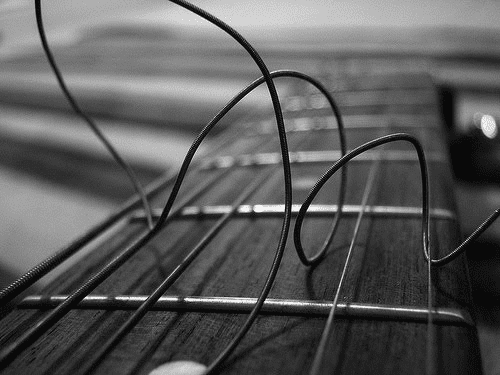
Guitar Strings: A Primer
by Jamey Mann, Catoctin School of Music
What kind of strings to use, how to change strings, and how often to change strings are all necessary things to know for anyone learning to play a stringed instrument. In the stringed instrument world, there are countless number of brands, types, materials, and attachment methods.
Many students get overwhelmed by having to buy or change their strings, so they will take their instrument to a store to have strings replaced. They’ll end up paying too much and having to leave their instrument overnight at a shop. I make a point to make string changing part of my lessons. If students are too young or are not able to change the string, I will gladly offer to change strings for them or teach their caregivers how to do so.
The following is a little primer on guitar strings relating to the three most common types of guitars.
- Classical/Flamenco guitar strings- Originally made from animal gut, modern classical guitar strings are made from nylon or other synthetic materials. The treble strings are made from a single nylon piece while the bass strings are often nylon fibers wrapped in metal. These strings are often used in classical/flamenco guitar music and typically have a warmer sound. However, that sound will vary depending on the type of string and guitar. It is highly recommended to not use steel strings on a nylon string guitar. Nylon stringed instruments are not typically designed to endure the tension of steel strings and this will result in damage to the instrument.
Classical/Flamenco guitar strings tie onto the tie block of the guitar’s bridge. This makes it difficult for most new guitar students to do on their own. I will often walk students through changing these strings a couple times before they try it on their own. Nylon strings are very easy on the fingers which make them a better choice for young students and beginners.
- Steel string acoustic strings- These guitars use steel strings, however the metals used can vary on desired sound and personal preference. Generally, the sound of acoustic guitars is loud and bright used for many styles of music such as rock, country, and blues.
Because they use steel strings and are generally larger instruments these guitars are not recommended for beginners. However, changing strings on an acoustic guitar is an easier task. The end of a steel has a brass ball which is held by a bridge pin in the saddle of the guitar.
- Electric guitar strings – Although thinner than acoustic guitar strings, electric guitar strings are made from steel. Due to the magnetic pickups used in electric guitars, strings are composed of highly magnetic steel. Also due to electronics, electric strings are thinner and do not have as much tension as acoustic steel string guitars, making them easier to play on. Even though they are made from steel, acoustic steel strings and electric steel strings are not the same. Acoustic steel strings use less magnetic materials which do not work well on electric guitars.
Electric strings are also easier to change as they also have a ball at the end of the string holding it to the guitar. However, there are many different variations of electric guitar with their own unique attachment methods.
The most important thing to remember is to choose strings that are specific to the type of guitar you are playing. And if you’re not confident in installing them, just have your teacher show you! That’s what teachers love… teaching new skills and making self-sufficiency a priority! Keep an eye out to learn more! I’ll be writing a follow up post to discuss string gauges, tension, materials, and personal recommendations.
